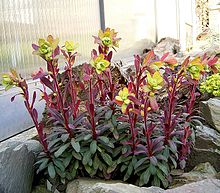Almond-leaved milkweed
| Almond-leaved milkweed | ||||||||||||
|---|---|---|---|---|---|---|---|---|---|---|---|---|

Almond Spurge ( Euphorbia amygdaloides ) |
||||||||||||
| Systematics | ||||||||||||
|
||||||||||||
| Scientific name | ||||||||||||
| Euphorbia amygdaloides | ||||||||||||
| L. |
The almond-leaved spurge or almond-spurge ( Euphorbia amygdaloides ) is a European plant from the genus Spurge ( Euphorbia ) that grows in deciduous forests .
description
The almond-leaved milkweed is a perennial , herbaceous plant that reaches a height of 30 to 70 cm. The plant overwinters with green leaves. The stems are erect or ascending. The leaves are alternate and are clustered in rosettes in the center of the flowering shoot. Your leaf blade is entire, obscured eilanzettlich and narrowed into the short petiole . They are usually hairy on the underside and on the edge. The leaves on the non-flowering shoots are 4 to 7 cm long, always without stipules.
The partial inflorescences form a up to neunstrahlige bill umbel , often standing sideways including additional partial inflorescences. The bracts are fused in pairs to form cups. The nectar glands are crescent-shaped. The flowering period extends from April to June. The pollination is effected by dipterans (Diptera).
The capsule fruits are three-furrowed, glabrous and finely dotted. The seeds carry an elaiosome that emerges from the caruncula . The seeds are mainly spread by ants ( myrmecochory ).
The number of chromosomes is 2n = 18 or 20.
Distribution and locations
This species occurs in southern and central Europe, in the Balkans, in the central Mediterranean and in the Black Sea and southern Caspian Sea. It is a meridional / montane to temperate floral element of oceanic Europe. In Germany it occurs scattered in the south, but largely absent in the north. In Austria it is often to scattered and is only absent in East Tyrol .
Almond-leaved milkweed grows in limestone beech forests, in oak-hornbeam forests and in alluvial forests. It prefers fresh, nutrient-rich, rather calcareous cheesecloth. She is a clay pointer. It occurs up to the montane altitude level .
In the plant-sociological system, it is an order character of the Fagetalia sylvaticae and occurs mainly in the associations Fagion sylvaticae , Carpinion betuli and Alno-Ulmion minoris.
Subspecies
There are three subspecies:
- Euphorbia amygdaloides subsp. amygdaloides : It occurs in the Mediterranean area and in Europe to Central Asia.
- Euphorbia amygdaloides subsp. arbuscula Meusel : It occurs in southern Italy and Sicily.
- Euphorbia amygdaloides subsp. robbiae (Turrill) Stace : It comes from the north-west of Turkey.
Cultivated varieties
Several varieties are cultivated. Here is a selection:
- 'Atropurpurea'
- 'Rubra'
- 'Variegata'
supporting documents
- Manfred A. Fischer, Karl Oswald, Wolfgang Adler: Excursion flora for Austria, Liechtenstein and South Tyrol . 3rd, improved edition. State of Upper Austria, Biology Center of the Upper Austrian State Museums, Linz 2008, ISBN 978-3-85474-187-9 .
- Siegmund Seybold (Ed.): Schmeil-Fitschen interactive . CD-ROM, version 1.1. Quelle & Meyer, Wiebelsheim 2002, ISBN 3-494-01327-6 .
- Rudolf Schubert , Klaus Werner, Hermann Meusel (eds.): Excursion flora for the areas of the GDR and the FRG . Founded by Werner Rothmaler. 13th edition. tape 2 : vascular plants . People and knowledge, Berlin 1987, ISBN 3-06-012539-2 .
Individual evidence
- ^ Erich Oberdorfer : Plant-sociological excursion flora for Germany and neighboring areas . 8th edition. Verlag Eugen Ulmer, Stuttgart 2001, ISBN 3-8001-3131-5 . Page 638.
- ↑ Eckehart J. Jäger, Friedrich Ebel, Peter Hanelt, Gerd K. Müller (eds.): Exkursionsflora von Deutschland . Founded by Werner Rothmaler. tape 5 : Herbaceous ornamental and useful plants . Springer, Spektrum Akademischer Verlag, Berlin / Heidelberg 2008, ISBN 978-3-8274-0918-8 , pp. 262 . >
- ↑ a b c d Rafaël Govaerts (Ed.): Euphorbia amygdaloides. In: World Checklist of Selected Plant Families (WCSP) - The Board of Trustees of the Royal Botanic Gardens, Kew . Retrieved December 2, 2015.
- ↑ Walter Erhardt among others: The great pikeperch. Encyclopedia of Plant Names . Volume 2. Verlag Eugen Ulmer, Stuttgart 2008. Page 1407. ISBN 978-3-8001-5406-7
Web links
- Almond-leaved milkweed. In: FloraWeb.de.
- Profile and distribution map for Bavaria . In: Botanical Information Hub of Bavaria .
- Euphorbia amygdaloides L. In: Info Flora , the national data and information center for Swiss flora .
- Thomas Meyer: Data sheet with identification key and photos at Flora-de: Flora von Deutschland (old name of the website: Flowers in Swabia )



